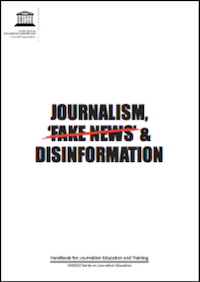
Journalism, 'Fake News' and Disinformation: A Handbook for Journalism Education and Training
journalism_fake_news.jpg

Developments in the last few years have placed journalism under fire. A range of factors are transforming the communications landscape, raising questions about the quality, impact and credibility of journalism. At the same time, orchestrated campaigns are spreading untruths - disinformation, mal-information and misinformation - that are often unwittingly shared on social media:
- Disinformation: Information that is false and deliberately created to harm a person, social group, organisation or country
- Misinformation: Information that is false but not created with the intention of causing harm
- Mal-information: Information that is based on reality, used to inflict harm on a person, social group, organisation or country.
Written by experts in the fight against disinformation, this handbook explores the very nature of journalism with modules on why trust matters; thinking critically about how digital technology and social platforms are conduits of the information disorder; fighting back against disinformation and misinformation through media and information literacy; fact-checking 101; social media verification and combatting online abuse.
This model curriculum is an essential addition to teaching syllabi for all journalism educators, as well as practicing journalists and editors who are interested in information, how we share it and how we use it. It is mission critical that those who practice journalism understand and report on the new threats to trusted information. Political parties, health professionals, business people, scientists, election monitors and others will also find it useful.
For background information on this publication, click here or read about the launch here
We also highly recommend watching this Facebook Live interview, which can also be used as a teaching tool.
You can find out more on F*ke News by watching Mr George Papagiannis Chief, Media Services at UNESCO and co-author, Julie Posetti, discuss ‘F*ke News’ and its impact on journalism and democracy on Facebook live.
Download Full Colour Version
- Albanian
- Arabic
- Bosnian
- Burmese
- Dutch
- French
- Georgian
- Indonesian
- Kazakh
- Khmer
- Korean
- Kyrgyz
- Macedonian
- Malaysian
- Persian
- Portuguese
- Romanian
- Russian
- Spanish
- Tajik
- Tetum
- Thai
- Vietnamese
Download Print-Friendly version
Download Individual Modules
Further Reading
To explore the history of the information disorder, the International Center for Journalists (ICFJ) has published a learning module, A Short Guide to the History of 'Fake News' and Disinformation, which journalism educators may find as a helpful addition to the UNESCO handbook. Click here for more information.
Discover articles on ‘Fake News’ published in the UNESCO Courier July-September-2017 issue:
- Ethical journalism: back in the news
- Fake news: sound bites on a burning topic
- Developing a critical mind against fake news
International Programme for the Development of Communication
To find out more about the IPDC and its projects, click here.
News
- 1 of 4
- next ›






